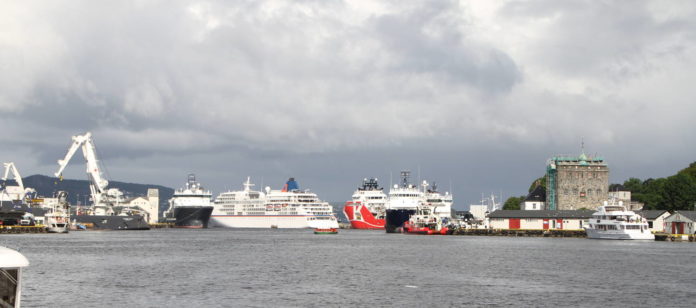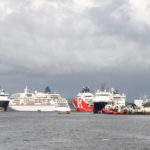
The Norwegian government has announced major investments of more than 1 bn NOK
in port related infrastructure during the next twelve months. A number of Norwegian ports have plans of their own to expand their business. By Thomas Wägener
The groundwork should be done to develop safe and e[ds_preview]fficient shipping along the Norwegian coast, said Ketil Solvik-Olsen, Minister of Transport. A major part of the 31.7 bn NOK that are reserved for the maritime industry will be used to develop and modernise the navigational infrastructure. The backlog to quays and breakwaters etc. will be fully reserved during the twelve year period, the government informs.
Also Narvik, the second biggest port of Norway, and Karmsund, the third biggest, have plans for expansion. For Narvik the export of iron ore is a key business. Capesize bulk carriers coming from Narvik bring iron ore to Hamburg’s Hansaport on a regular basis, amounting to approximately 2,5mill. t. annually, informs Hansaport Manager Ben Thurnwald. Therefore, Narvik is an important port for Germany.
The bulk terminal in Narvik with a berth for vessels of up to 180,000 dwt and a shiploader type PL 100 manufactured by Sandvik, is owned by LKAB Norge. The company is a subsidiary of the Swedish LKAB (Luossavaara-Kiirunavaara Aktiebolag) which is focused on industrial minerals. The iron ore is transported by train from the Swedish iron ore pits in Gällivare and Kiruna to Narvik. About 20mill. t of the raw material are handled in the Norwegian port per year. But LKAB expects that it will be about 34mill. t a year by 2020. Therefore, the company has big plans for a new port located at the south side of the Narvik peninsula (13km). There the iron ore specialist sees a possibility for a new logistics hub where a new bulk terminal could be combined with an industrial park or a container port within the next five to eight years. Two quays of 800m and 600m length are planned. There are also plans to supply LNG (liquefied natural gas) to the regional market as well as for bunkering of ships.
Karmsund is the third largest Norwegian port in terms of cargo throughput. The goal of the Karmsund Port Authority is to become the most important maritime logistics hub on the Norwegian west coast. Thus, it will begin a major development of the Husøy cargo port in Karmøy this year. This represents an investment of roughly 300mill. NOK. More than 700.000m3 of spoil are to be removed from sites associated with the cargo terminal and used to reclaim land from the sea. All in all, some 22ha of new effective surface will be developed. A future-oriented approach is being taken to planning the development and the port upgrade. The Karmsund Port Authority aims to build a facility which is high-tech, efficient and environment-friendly.
Husøy terminal is located on the main shipping channel along the Norwegian west coast, meaning virtually zero deviation and the potential for very efficient calls. In order to fully exploit this advantage, the Port Authority is planning to install vacuum-based automated mooring delivered by Cavotec.
In addition, the Karmsund Port Authority wants to make provisions for other types of environment-friendly fuels. Norlines, one of the port’s current customers, already calls Husøy on a regular basis with its two LNG-fuelled ships, »Kvitbjørn« and »Kvitnos«. According to the port authority they use 18% less energy than the vessels they have replaced. Carbon emissions are reduced by 38% and nitrogen oxide emissions by 90%, while sulphur oxide and particle emissions have been completely eliminated. An LNG tank which provides bunkering for such vessels is planned to be installed in the port.
Biofuels could be another option, especially for older vessels. These include hydrotreated vegetable oil (HVO), a relatively new option. The HVO production process yields a biofuel of very good quality which can be used directly in existing engines. It is made from various vegetable oils and abattoir waste. The Karmsund Port Authority wants to look into opportunities to also offer bunkering of biofuels.
According to Statistics Norway, the ten biggest Norwegian ports together handled 180,767mill. t of goods in 2016, nearly one third was shipped via Bergen, the biggest port of the country. More than 300 cruise vessels visit Bergen every year with about 550,000 passengers on board. Four to six ships with a maximum length of 333m may berth at the same time. For the western part of the country, Bergen also is an important hub where all types of cargo are handled. The nordic country’s second largest city is a supply base for offshore installations in the North Sea. Other advantages for Bergen are the lack of tidal restrictions and ice free conditions even during winter. According to Statistics Norway, in Q4 of 2016 the oil export rose to 8.6mill. t. This is nearly twice the figure of Q4 2015.
Located within the Bergen harbour district are marine oil refineries, a number of bunkering facilities and well-equipped workshops including slipways, dry docks and floating docks. The port privides cranes with lifting capacities of up to 125t. In addition, ship agents like Greencarrier Shipping & Logistics, Nor Lines, Kuehne & Nagel, Bring Logistics, Sea Cargo Agencies and Wilhelmsen Agencies, have access to a wide range of equipment, including trucks with a lifting capacity of up to 42t, terminal tractors and lorries.
Depending on port infrastructure
Norway has strong trade relations with the EU. According to the German Ministry of Foreign Affairs, more than 80% of the total Norwegian exports go to EU member states. On the other hand, EU member states account for 65% of Norway’s imports. The largest foreign trade partners are Germany, the UK, Sweden, the Netherlands, China and the USA. Norway owns 42% of the Western European conventional oil and gas reserves. Oil and gas products total to more than 60% of all Norwegian exports. Therefore, it is also necessary for the country to have a good port infrastructure.
The Port of Grenland is owned by the municipalities of Bamble, Porsgrunn and Skien, and is environmentally certified to ISO 14001 standards. A wide range of cargo were handled there, for example dry bulk, wet bulk, general cargo, and containers, totaling 10.8mill. t per year. The terminals have the capacity to host vessels up to 150,000 dwt. More than 2,500 ships call Grenland each year. At Tangen quay at Brevik Terminal coal ships with a length of 200m can berth. The roro terminal has a length of 180m and includes two roro ramps, each with a width of 32 m. Railway tracks are located right down the quay. The terminal company, North Sea Terminals, operates the LoLo Breivik Terminal. According to Port of Grenland, it is among Norway’s largest roro terminals. It features facilities for lolo, roro and dry bulk handling. From Langesund Ferry Terminal Fjord Line has daily departures to Hirtshals, Stavanger and Bergen.
The dry bulk quays at Portsgrunn include the crane quay with a length of 230m at 6,70m gauge, the deep water quay with a length of 175m and a depth of 9.70m and the 150m long Tinfos quay at 6,70m gauge.
At Skien Harbour Terminal general cargo and dry bulk are handled. There is one 135m quay with a depth of 9.5m and another with a length of 165m with the same depth. The roro ramp measures 30m. In addition the stone quay has a depth of 10m.
Oslo is Norway’s leading cargo and ferry port. 50 to 70 cargo or passenger vessels call this hub every week. In 2016, 81 cruise ships have docked with 155,000 visitors aboard. But this is a decrease compared to 2015 when 102 vessels with nearly 200,000 passengers berthed. The cruise traffic centre includes four piers with lengths from 249m to 345m, all located close to the city centre.
There are three daily ferry arrivals from Denmark and Germany. Ferry operator Color Line links the German port of Kiel with the Norwegian capital city and DFDS have a connection to Denmark. But Oslo also has a container handling facility. The Sjursøya Container Terminal is the largest of the country. It is operated by Yilport and has a throughput capacity of 300,000 TEU. Cargo is handled with two Konecranes gantry cranes with a liftig capacity of 64t and an outreach of 40m, that go across 15 rows of boxes. Kalmar delivered two more cranes with a capacity of 61t and an outreach for vessels with up to 18 rows. Kalmar also supplied eight RTGs with a lifting capacity of 50t each, two reachstackers with 45t lifting capacity and twelve terminal tractors. Two Linde-C90 and three Nissan-DX30 complete the terminal equipment.
Thomas Wägener


















